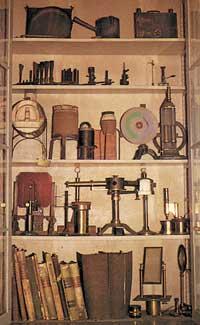Gay-Lussac, an elegant science

As a young man, his assistant from Berthollet opened many doors for him, as leading scientists of the time such as Lavoisier and Laplace met in his rural house in Arcueil.
XIX. At the beginning of the 20th century, chemistry, unlike physics, still did not get a mathematical model to explain and predict facts. Mathematician Laplace defended a mathematical model to explain chemistry. He believed in the regularity of the physical environment and thought that reactions could be expressed simply by formulas.
His work can be considered an example of a scientific method. One of the clearest examples is the rise to the aerostat. In September 1804 it rose to seven thousand meters of altitude in the aerostat. His intention was to check whether the Earth's magnetic field and air composition vary or not with altitude.
First he made an ascent of up to four thousand meters accompanied by the mathematician Biot. On that rise the intensity of the Earth's magnetic field was measured. In the following he climbed only up to seven thousand meters. In this ascension, in addition to the intensity of the magnetic field, he measured temperature and pressure and was collecting air samples as he ascended. In this second ascension it reached the highest altitude until then and it took half a century to rise again to more than seven thousand meters.

After analyzing the measurements made in the aerostat and the collected samples, he concluded that both the Earth's magnetic field and air composition remained constant, at least up to six thousand meters. This latter determination is very significant and shows that Gay-Lussac did not want absolute affirmations and knew the limits of his work.
Today it is known that as it rises in height, although there is less air, the relationship between the components is the same, so the first hundred kilometers of the atmosphere are called homosfers. The magnetic field can also be said to remain constant as it rises in height.
Think about the degree to which Gay-Lussac was methodical: although the aerostat measurements did not conform to the results obtained by Alexander Von Humbolt, the prestigious Prussian researcher recognized the accuracy of Gay-Lussac's work and showed his desire to collaborate. Thus, in 1804 the proportions of hydrogen and oxygen reacting to form water were measured. They saw that the two volumes of hydrogen formed water with a single volume of oxygen. And this result questioned the work of another researcher, since Dalton, measuring the masses of hydrogen and oxygen, did not get such a round number in proportionality. However, Dalton did not take into account the seriousness of Gay-Lussac's investigation and accused him of cheating to achieve the desired result.
Law of Gay-Lussac

Following this research, his best-known work came in 1808: Combining Volumes Act. This law, also known as the Gay-Lussac Law, confirms that by combining gases they do so in simple volume relationships. Thanks to this, among other things, Berzelius built in 1828 the first table of atomic weights.
However, Gay-Lussac's work in gas diffusion cannot be omitted. In 1802 he published the Gas Extension Act, which was later called the Charles Law. In fact, before Jacques Charles obtained similar results, although later they were published. According to this law, the volume of a gas is proportional to its absolute temperature at constant pressure, so all gases expand in the same proportion as the temperature increases.
This law opened up new avenues. Based on the laws 2 and 3 of thermodynamics, Avogadro also took it into account when considering his hypothesis. According to this hypothesis, all gases have the same number of particles per unit of volume at a certain temperature. This hypothesis was rejected by the scientists of the time and did not have much audience until decades later. But it would be important for Gay-Lussac if he had accepted it, as he could explain why his law and that of Dalton did not fit.
As can be seen, Gay-Lussac was a refined and methodical scientist, but also heady.

The French scientist worked in several fields. Together with Laplace he researched capillarity and with the help of Thenard discovered the boron element. Inventor of the absorption tower for sulfuric acid production, the Gay-Lussac Towers were used in the industry to obtain sulfuric acid well into the twentieth century. He also worked on improving laboratory tools such as pipette and buret. As you can see, Gay-Lussac was not a man to be still.





